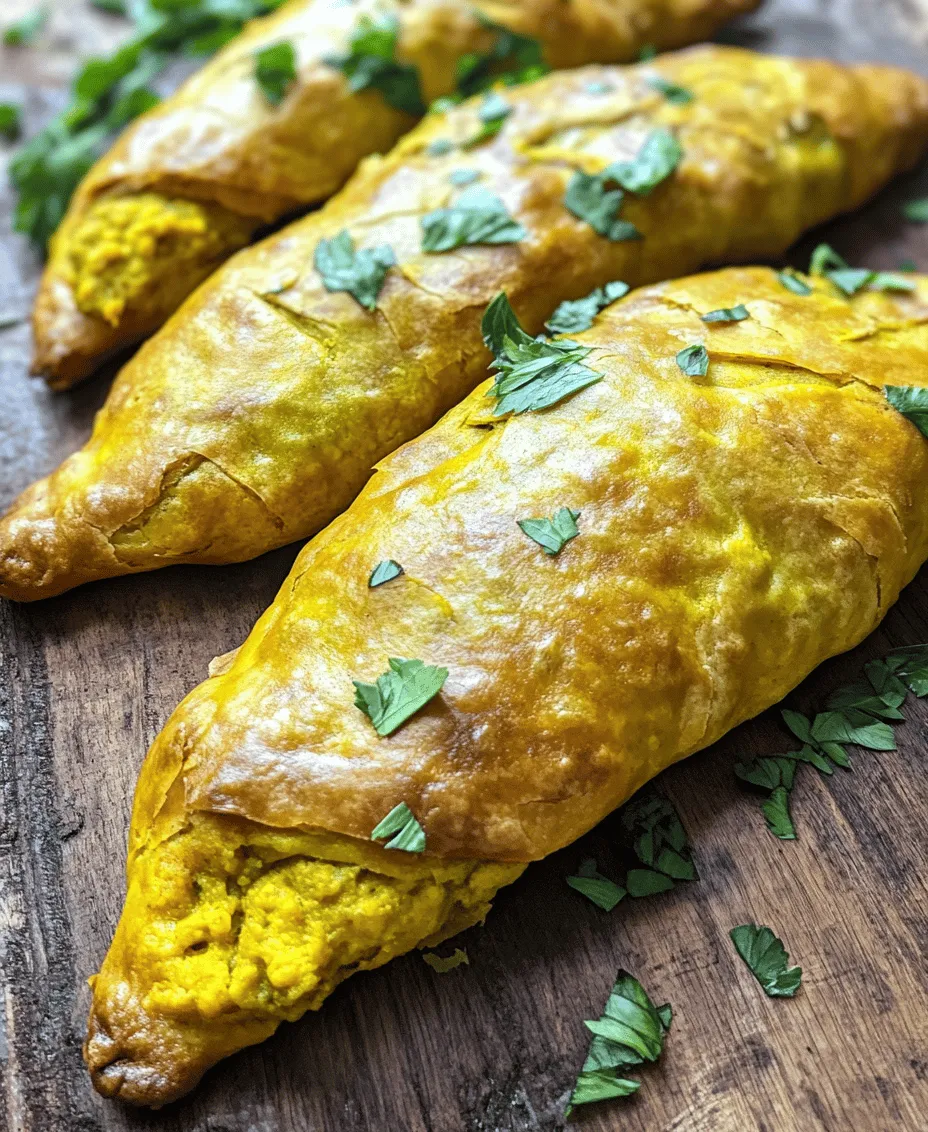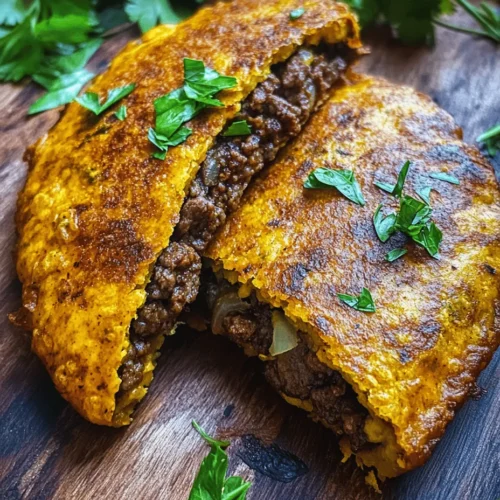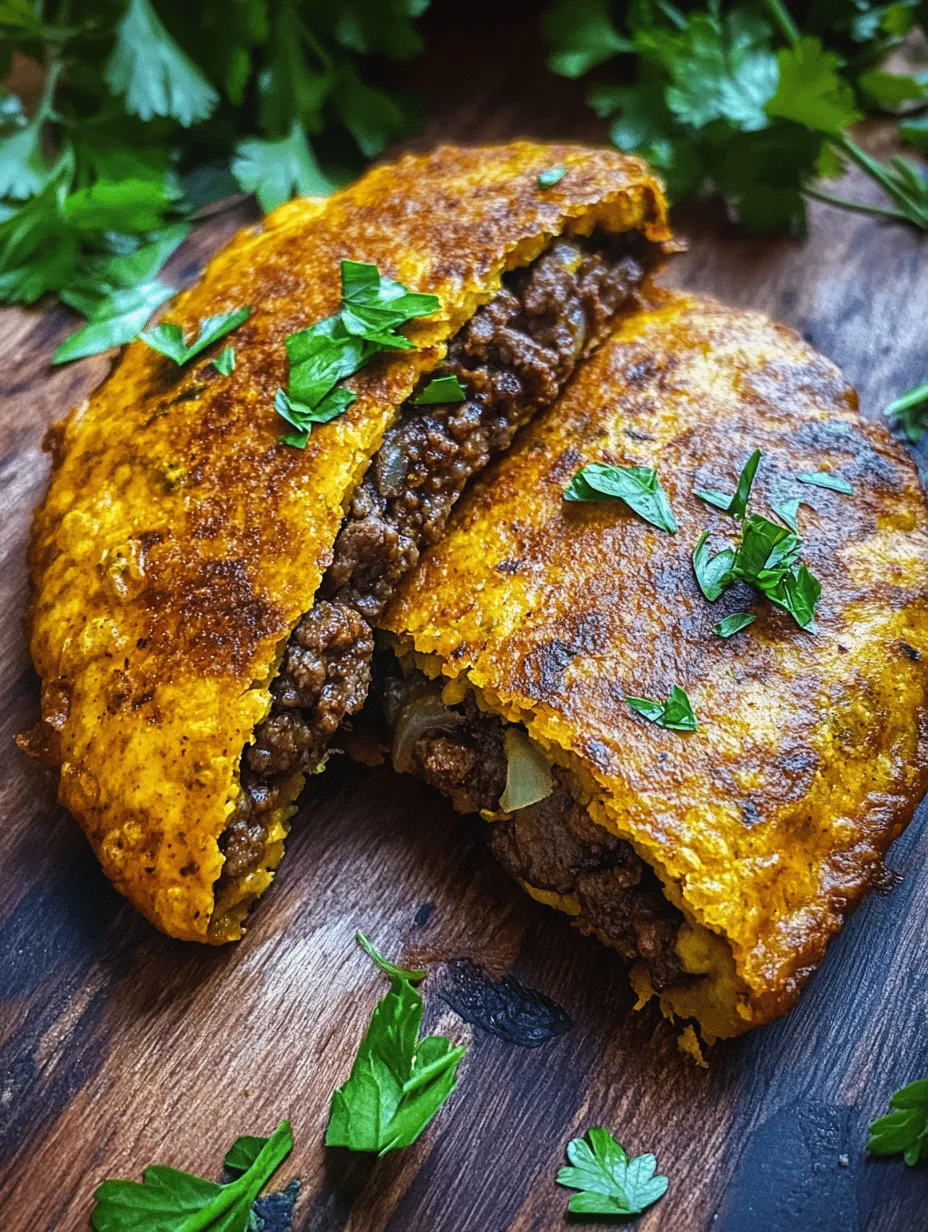Introduction
Jamaican beef patties are not just a popular snack; they are a cultural staple that reflects the vibrant and diverse culinary heritage of the Caribbean. With their flaky, golden crust and savory spiced filling, these pastries are a beloved choice for many, from street vendors to family kitchens. The allure of homemade Jamaican beef patties lies not only in their delightful taste but also in the ability to customize flavors and ingredients to suit personal preferences.
In this article, we’ll take you on a journey through the rich history of Jamaican beef patties, explore the essential ingredients that make these pastries so special, and guide you step-by-step in creating your own delicious version at home. Whether you’re a seasoned cook or a beginner in the kitchen, our structured approach will ensure you navigate the recipe with ease and confidence.
Understanding Jamaican Beef Patties
Historical Context of Jamaican Beef Patties
The origins of Jamaican beef patties can be traced back to the island’s colonial history, where influences from African, Indigenous, and European cuisines intermingled to create a vibrant food culture. The concept of meat-filled pastries is not unique to Jamaica; however, the way they are prepared and seasoned sets Jamaican beef patties apart. Originally inspired by the British Cornish pasty, the Jamaican variant has evolved to incorporate local flavors and spices, making it a distinct culinary creation.
In Jamaica, beef patties have become a symbol of street food culture. Vendors sell them hot and fresh, often served alongside a cold drink as a perfect snack or meal on the go. Today, they are enjoyed not only in Jamaica but also in many parts of the world, particularly where there are Jamaican communities.
Differences Between Jamaican Beef Patties and Other Similar Pastries Worldwide
While many cultures have their own versions of meat-filled pastries—such as empanadas in Latin America or samosas in South Asia—Jamaican beef patties stand out for their unique combination of spicing and pastry texture. The crust of a Jamaican beef patty is typically flaky and tender, thanks to the incorporation of turmeric, which adds not only color but also a subtle flavor. The filling is often seasoned with an array of spices, including allspice, thyme, and the fiery Scotch bonnet pepper, which imparts a distinctive heat that is a hallmark of Jamaican cuisine.
In contrast to some other pastry varieties that may have a more uniform filling, Jamaican beef patties often feature a rich, spiced beef mixture that is both hearty and flavorful. This makes them a versatile option for any meal, whether enjoyed at breakfast, lunch, or dinner.
Importance of Spices and Local Ingredients in Caribbean Cuisine
Caribbean cuisine is renowned for its bold flavors, heavily influenced by the region’s unique mix of cultures and available local ingredients. Spices play a crucial role in the preparation of Jamaican beef patties, transforming simple ingredients into a complex and satisfying dish. The use of fresh herbs, such as thyme, and spices like allspice and nutmeg, showcases the island’s agricultural bounty while adding depth to the overall flavor profile.
Moreover, the inclusion of Scotch bonnet peppers introduces a distinctive heat that can be adjusted based on personal preference. This emphasis on fresh, local ingredients not only enhances the taste of the patties but also pays homage to the island’s farming traditions, where many of these ingredients are grown.
Ingredients Breakdown
Overview of the Dough Ingredients
To create the perfect Jamaican beef patty, we must begin with the dough, which forms the delicious shell that encases the flavorful filling. The key ingredients for the dough include:
– All-purpose flour: This is the primary component of the dough, providing the necessary structure.
– Salt: Enhances the flavor and balances the sweetness of the other ingredients.
– Turmeric: This spice is essential for giving the dough its signature golden hue and subtle flavor.
– Cold unsalted butter: The texture of the dough relies heavily on butter, which should be kept cold to achieve the desired flakiness.
Role of All-Purpose Flour, Salt, and Turmeric in the Dough
All-purpose flour serves as the backbone of the dough, providing the necessary gluten structure that gives the patties their shape. When combined with cold butter, the flour creates layers that will flake beautifully upon baking. Salt is a crucial ingredient that elevates the overall flavor of the dough; it ensures that the pastry is seasoned, preventing it from tasting bland.
Turmeric is not just a coloring agent; it also contributes a mild earthiness to the dough, complementing the savory filling perfectly. This combination of ingredients creates a rich, flavorful crust that is key to the overall success of the Jamaican beef patty.
Importance of Using Cold Unsalted Butter for Texture
Using cold unsalted butter is paramount to achieving the right texture in the dough. Cold butter creates pockets of steam as it melts during baking, resulting in a flaky and tender pastry. Unsalted butter is preferred since it allows you to control the salt content in the dough, ensuring that it doesn’t overpower the flavors of the filling.
Overview of the Filling Ingredients
Once the dough is ready, the next step is to prepare the filling, which is where the magic really happens. The primary ingredients for the filling include:
– Ground beef: The base protein that provides richness and heartiness to the patties.
– Spices: A blend of spices, including allspice, black pepper, and thyme, that infuses the beef with flavor.
– Aromatics: Ingredients like onion, garlic, and bell pepper that add depth to the filling.
– Scotch bonnet pepper: This ingredient brings heat and is a defining characteristic of Jamaican cuisine.
Explanation of Each Ingredient: Ground Beef, Spices, and Aromatics
Ground beef is the star of the filling, providing a juicy and satisfying bite. When combined with spices, it takes on a complex flavor profile that is both savory and aromatic. Allspice is particularly noteworthy; its unique flavor is often described as a blend of cinnamon, nutmeg, and clove, making it a quintessential spice in many Caribbean dishes.
The inclusion of aromatics such as onion, garlic, and bell pepper enhances the filling’s flavor, adding sweetness and depth. These ingredients work together to create a well-rounded and flavorful mixture that will delight your taste buds.
The Influence of Scotch Bonnet Pepper on Flavor and Heat
Scotch bonnet peppers are a hallmark of Jamaican cuisine, known for their intense heat and fruity flavor. They add a distinctive kick to the beef filling, making Jamaican beef patties exciting and memorable. The level of heat can be adjusted according to personal preference; if you prefer a milder filling, consider using less of the pepper or substituting it with a less spicy variety.
Discussion on Optional Ingredients: Breadcrumbs and Their Texture Contribution
While the basic filling is delicious on its own, some recipes include breadcrumbs to enhance texture. Breadcrumbs can help bind the filling together, resulting in a slightly firmer consistency. This addition can be beneficial if the ground beef is particularly lean, as it helps retain moisture and prevents the filling from becoming too dry.
Importance of the Egg Wash for a Golden Finish
Before baking, the patties are brushed with an egg wash, a mixture of beaten egg and water. This simple step is crucial for achieving a beautiful golden-brown color on the crust. The egg wash also adds a slight sheen, making the patties visually appealing and inviting. For a vegetarian alternative, you can use a mixture of milk or a plant-based milk substitute with a bit of oil.
Preparing the Dough
Step-by-Step Guide to Mixing the Dough
Now that we’ve covered the ingredients, let’s dive into the process of preparing the dough for our Jamaican beef patties. Follow these steps for a successful outcome:
1. Combine the dry ingredients: In a large mixing bowl, combine the all-purpose flour, salt, and turmeric. Whisk them together until they are evenly mixed.
2. Incorporate the cold butter: Cut the cold unsalted butter into small cubes and add it to the flour mixture. Using a pastry cutter or your fingers, work the butter into the flour until the mixture resembles coarse crumbs. Be careful not to overwork the dough; you want to maintain small pieces of butter for flakiness.
3. Add water gradually: Slowly add ice-cold water, one tablespoon at a time, mixing until the dough begins to come together. You may not need to use all the water, so add it gradually to prevent the dough from becoming too wet.
4. Knead gently: Once the dough comes together, turn it out onto a lightly floured surface. Knead it gently for about a minute until it is smooth. Avoid over-kneading, as this can develop gluten and make the dough tough.
5. Chill the dough: Wrap the dough in plastic wrap and refrigerate it for at least 30 minutes. Chilling allows the butter to firm up, which is crucial for achieving a flaky texture in the final product.
Tips for Achieving the Right Texture
Achieving the perfect texture in your dough is essential for delicious Jamaican beef patties. Here are some tips to keep in mind:
– Work quickly: The less time the dough spends at room temperature, the better. Warm butter can lead to a dough that is less flaky, so keep everything as cool as possible.
– Use a light touch: When mixing and kneading the dough, use a gentle touch to avoid overworking it. The goal is to keep the butter in small pieces, which will create the desired layers.
– Test the dough: If you’re unsure whether your dough is ready, perform the “finger test.” Press your finger into the dough; if it springs back, it’s ready to chill.
With the dough prepared, we can now move on to crafting the flavorful filling for our Jamaican beef patties. Stay tuned for the next section, where we will guide you through the process of creating a savory and aromatic filling that will elevate your patties to new heights.

Techniques for Sautéing Onions, Garlic, and Ginger for Maximum Flavor
To create the perfect filling for your Jamaican beef patties, the sautéing of onions, garlic, and ginger is crucial. Start by finely dicing one medium onion, mincing three cloves of garlic, and grating a one-inch piece of fresh ginger. Heat a tablespoon of vegetable oil in a skillet over medium heat. Once the oil is shimmering, add the onions. Stir frequently, allowing them to become translucent and slightly caramelized, which usually takes about 5-7 minutes.
After the onions have softened, add the minced garlic and grated ginger. Stir them in and sauté for an additional 1-2 minutes until fragrant. This technique not only enhances the flavor of your filling but also creates a wonderful aromatic base that pairs beautifully with the savory notes of the ground beef.
Importance of Seasoning the Ground Beef Properly
Seasoning your ground beef is essential for elevating the overall taste of your patties. In a separate bowl, combine the ground beef with a mix of spices to enhance its flavor. Consider using a blend of salt, black pepper, allspice, thyme, and a pinch of cayenne for a hint of heat. Don’t be afraid to taste as you go; adjust the seasonings based on your preference.
Once seasoned, add the sautéed onion, garlic, and ginger mixture to the beef. Mix well, ensuring that each bite of the filling is bursting with flavor. Proper seasoning is key to achieving that authentic Jamaican taste, so take your time to ensure each ingredient is well incorporated.
Explanation of the Simmering Process and Its Role in Flavor Development
After mixing in the sautéed ingredients, it’s time to simmer the filling. This step is crucial as it allows the flavors to meld together beautifully. Add a splash of beef broth or water to the mixture and bring it to a gentle simmer over low heat. Cover the skillet and let it simmer for about 10-15 minutes. This process not only enhances the taste but also tenderizes the meat, resulting in a juicy filling.
As the mixture simmers, occasionally stir to prevent sticking, and check the moisture level. If it appears too dry, add a little more broth. The goal is to achieve a filling that is moist but not watery, which will help keep your patties from becoming soggy.
Assembling the Patties
With your flavorful filling ready, it’s time to assemble the patties.
Detailed Instructions on Rolling Out the Dough
Begin by rolling out the dough you’ve prepared earlier. On a lightly floured surface, use a rolling pin to flatten the dough into a thin, even layer, about 1/8 inch thick. It’s important to ensure that the dough is evenly rolled to prevent uneven cooking.
Recommended Tools for Cutting and Shaping Patties
To cut the patties, a round cutter or a small bowl with a diameter of about 4-5 inches works perfectly. If you don’t have a cutter, you can use a sharp knife to create circles. The key is to maintain uniformity in size for even baking. As you cut out the dough, place the circles on a floured baking sheet to prevent sticking.
Step-by-Step Guide for Filling and Sealing the Patties
Once your circles are ready, it’s time to fill them. Take a spoonful of the beef filling and place it in the center of each dough circle. Be careful not to overfill, as this can lead to leaks during baking.
Next, fold the dough over the filling to create a half-moon shape. Press the edges together firmly to seal. For an extra secure seal, you can crimp the edges with a fork. This not only reinforces the seal but also adds a decorative touch to your patties.
Tips for Ensuring a Proper Seal to Prevent Leaks During Baking
To ensure your patties don’t leak during baking, it’s important to ensure there are no air pockets in the filling. Press the edges firmly and consider brushing them lightly with an egg wash (a beaten egg) before sealing them. This creates a stronger bond and gives the patties a beautiful golden color when baked.
Baking to Perfection
With your patties assembled, it’s time to bake.
Preheating the Oven and Preparing the Baking Sheet
Preheat your oven to 375°F (190°C). While the oven warms up, line a baking sheet with parchment paper. This step is essential as it prevents the patties from sticking and ensures easy removal post-baking.
Importance of Parchment Paper for Easy Removal
Using parchment paper not only aids in preventing sticking but also allows for even heat distribution, which is crucial for achieving that perfect golden-brown color.
Baking Time and Temperature for Optimal Results
Place the patties on the prepared baking sheet, ensuring they have enough space between each one to allow for even cooking. Bake them for about 25-30 minutes or until they are golden brown. Keep an eye on them, as oven temperatures can vary.
Signs to Look for When the Patties Are Done
Your Jamaican beef patties are done when they have turned a rich, golden brown and emit a delicious aroma. Additionally, the crust should be crisp to the touch. If you’re unsure, you can slice one open to check that the filling is hot and cooked through.
Serving Suggestions
Ideal Serving Temperature for Jamaican Beef Patties
Jamaican beef patties are best served warm. The flaky crust paired with the savory filling is a delightful experience that’s enhanced when the patties are fresh out of the oven.
Recommended Dipping Sauces and Accompaniments
Consider serving your patties with a side of mango chutney or a spicy dipping sauce like a scotch bonnet pepper sauce for an extra kick. These accompaniments perfectly complement the flavors of the patties and add a refreshing contrast.
Suggestions for Meal Pairings and Cultural Context
Jamaican beef patties can be enjoyed as a snack, appetizer, or main dish. They pair well with a side of rice and peas or a simple salad featuring fresh vegetables. In Jamaican culture, these patties are often sold by street vendors and enjoyed on the go, making them a beloved comfort food that resonates with many.
Storage and Reheating Tips
How to Store Leftover Patties Properly
If you have any leftovers, allow the patties to cool completely before storing them. Place them in an airtight container in the refrigerator for up to 3 days. For longer storage, consider freezing them. Lay the patties on a baking sheet to freeze individually before transferring them to a freezer-safe bag or container. They can be stored in the freezer for up to 3 months.
Best Practices for Reheating Without Losing Texture
When reheating, it’s best to bake the patties in the oven to maintain their flaky texture. Preheat your oven to 350°F (175°C), then place the patties on a baking sheet and heat for about 10-15 minutes, or until warmed through. This method will help retain the exterior crispness that makes these patties so enjoyable.
Conclusion
Making homemade Jamaican beef patties is not just about following a recipe; it’s about embracing a culinary tradition that has been passed down through generations. The joy of crafting these flavorful pastries and sharing them with friends and family is an experience that transcends mere cooking.
As you enjoy your freshly baked patties, consider exploring variations of the recipe. You might try different fillings such as chicken, vegetables, or even spicy fish to keep things interesting. The beauty of Jamaican cuisine lies in its diversity and adaptability, allowing you to experiment and make it your own.
The cultural richness of Jamaican cuisine is evident in every bite of these savory beef patties. They are a testament to the island’s vibrant food culture and the warmth of its people. So, roll up your sleeves, get your ingredients ready, and create a batch of these delightful patties that will surely become a family favorite.



